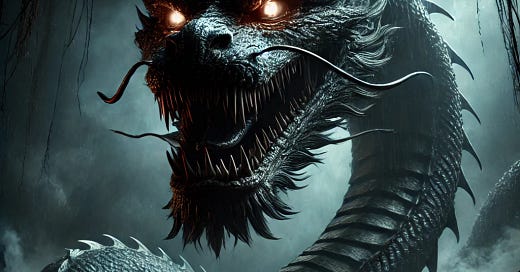Myth of the Day: Bashe
Explore ancient China's dark legends: a colossal serpent, enforcing cosmic justice, preys on corrupt souls, an ominous, invulnerable symbol of moral retribution.
Region/Culture: China, Asia
Mythos: Chinese Mythology
Primary Type/Nature: Monsters and Beasts
Mythical Attributes: The Bashe is a gigantic serpent that feasts on the corpses of humans.
Role in Mythos: In Chinese mythos, the Bashe is considered a malevolent creature, often appearing as an omen of death and darkness.
Relation to Humans: The Bashe is known to eat human corpses, particularly corrupt officials and individuals with evil deeds. Its appearance is generally seen as a bad omen, signaling calamity or death.
In the winding labyrinths of Chinese folklore, where dragons dance and phoenixes rise from the ashes, there exists a creature of haunting disposition—the Bashe. Contrary to the whimsical and sometimes benevolent beings we often meet in myth, the Bashe is a darker shade on the spectrum of fantastical creatures. Hailing from the complex tapestry of Asian legends, this enormous serpent is known to feast on the corpses of humans, more specifically those who were corrupt or evil in life.
Picture this: a serpent of gargantuan proportions, its body undulating like a river through the dark forests and mountainous terrains of ancient China. Not merely confined to the ground, this creature is sometimes said to take to the skies, unfurling invisible wings that catch the wind as easily as its scales repel any weapon. Covered in impenetrable scales, it slithers through time and space as an enduring symbol of death and darkness. Its very appearance is a morbid spectacle—its scales shimmering in the dim light of the underworld it frequents, its eyes gleaming with a preternatural hunger.
The tale of the Bashe’s origin is as enigmatic as the creature itself. Whispers and fragmented scrolls suggest that it was created as a form of cosmic justice, birthed from the yin—the dark, passive, and feminine principle in ancient Chinese cosmology—to balance the surplus of yang. Though malevolent in nature, the Bashe serves a unique purpose: to devour the corpses of corrupt officials and wrongdoers, thereby preventing their maleficence from polluting the Earth even in death.
Of course, a creature as grim as the Bashe does not exist solely in isolation. Its role in the mythos of the region often foreshadows calamity or death, making it an omen to be feared. Families whisper its name in trepidation and scholars write of it with caution. When the Bashe appears, it signals not just its own hunger, but the impending shadow of something far more sinister.
Regarding its abilities, the Bashe’s scales are said to be almost invulnerable, repelling weapons and the elements alike. Its sense of smell can detect the aroma of moral decay from miles away, leading it unerringly to its next meal. In some versions of the myth, the Bashe can even fly, making escape from its terrible judgement all but impossible.
But even this dark harbinger is not without its weaknesses. The Bashe is bound to the very cosmic principles that brought it into being. It cannot harm the innocent or those who are pure of heart. In some tales, the mere touch of a morally upright individual can send the Bashe recoiling into the shadows, its power momentarily waned.
In the grand narrative of mythical creatures, the Bashe is neither the most lovable nor the most celebrated, but it serves as a grim reminder of the complexities of good and evil, justice and corruption. It teaches us that even in the darkest corners of myth, there is a place for the uncomfortable, the unsettling, and the malevolent. So the next time you walk through a dark forest or pass by an ancient grave, remember the Bashe; it may just be lurking nearby, fulfilling its grim duty in the cosmic balance of things.
Suggested Further Reading
Explore more myths and wonders by visiting godsandmonsters.info.
Enjoy mythic tales on the move with our podcast, Five Minute Mythology.





